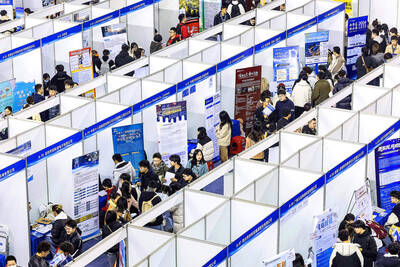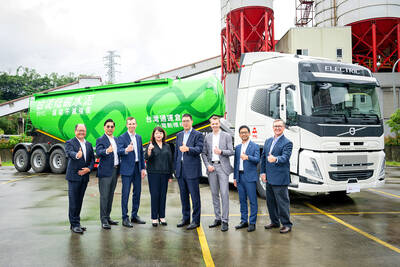Singapore Airlines Ltd plans to raise more liquidity after posting its biggest quarterly loss on record as COVID-19 decimated travel demand and charges from fuel hedging and fleet impairment weighed on its bottom line.
The airline is in advanced talks to raise funds in the debt capital market and by selling and leasing back some of its aircraft, chief executive officer Goh Choon Phong (吳俊鵬) said during a briefing yesterday, without elaborating.
Cash burn has fallen to about S$300 million (US$223 million) a month from about S$350 million in the three months to July, chief financial officer Stephen Barnes said.

Photo: EPA-EFE
The carrier has already raised S$11.3 billion in funds through a rights offering and loans in a bid to survive the downturn, and in September said it would reduce its workforce by about 20 percent.
Singapore Airlines reported a net loss of S$2.3 billion in the three months to September as international travel all but dried up.
The company expects to operate at about 50 percent of passenger capacity by the end of next year, up from 16 percent forecast for the end of this year.
Tapping the debt market and selling and leasing back planes should ensure the airline has “very strong” liquidity, Goh said.
“We have one of the strongest, if not the strongest liquidity position among airlines,” he said.
The carrier’s net cash and cash equivalent stood at S$7.06 billion at the end of September.
Singapore Airlines might need to decide toward the end of the first quarter whether to tap the S$6.2 billion in convertible bonds from a fundraising plan announced in March, Barnes said.
The airline’s shares yesterday fell 1.4 percent. They are down 46 percent this year, compared with a 19 percent drop for the benchmark Straits Times Index.
For the half-year that ended on Sept. 30, Singapore Airlines reflected S$1.3 billion in impairment charges on the removal of 26 older aircraft, after reviewing its network to determine the size and mix of its fleet over the longer term. They were eight Boeing Co 777s, seven Airbus SE A380s, nine A320s and two A319s.
Fuel hedging contributed to a S$563 million loss.
In 2017, Singapore Airlines extended some of its fuel-hedging contracts to as far out as five years, from the usual 24 months.
The airline on Friday said that it had paused fuel hedging activity since March given the uncertain pace of recovery.
Singapore Airlines has restarted some routes, including its non-stop service to New York, and plans to gradually reinstate flights to places such as Brunei, Kathmandu and Male.
Singapore is working to reopen its borders. It is planning a travel bubble with Hong Kong that would use tests to replace quarantine and it has opened to visitors from some countries deemed as low risk, including New Zealand and China.
Singapore Airlines last week said that it had set up a business offering training programs to other companies in a bid to generate additional revenue.

Stephen Garrett, a 27-year-old graduate student, always thought he would study in China, but first the country’s restrictive COVID-19 policies made it nearly impossible and now he has other concerns. The cost is one deterrent, but Garrett is more worried about restrictions on academic freedom and the personal risk of being stranded in China. He is not alone. Only about 700 American students are studying at Chinese universities, down from a peak of nearly 25,000 a decade ago, while there are nearly 300,000 Chinese students at US schools. Some young Americans are discouraged from investing their time in China by what they see

MAJOR DROP: CEO Tim Cook, who is visiting Hanoi, pledged the firm was committed to Vietnam after its smartphone shipments declined 9.6% annually in the first quarter Apple Inc yesterday said it would increase spending on suppliers in Vietnam, a key production hub, as CEO Tim Cook arrived in the country for a two-day visit. The iPhone maker announced the news in a statement on its Web site, but gave no details of how much it would spend or where the money would go. Cook is expected to meet programmers, content creators and students during his visit, online newspaper VnExpress reported. The visit comes as US President Joe Biden’s administration seeks to ramp up Vietnam’s role in the global tech supply chain to reduce the US’ dependence on China. Images on

Taiwan Transport and Storage Corp (TTS, 台灣通運倉儲) yesterday unveiled its first electric tractor unit — manufactured by Volvo Trucks — in a ceremony in Taipei, and said the unit would soon be used to transport cement produced by Taiwan Cement Corp (TCC, 台灣水泥). Both TTS and TCC belong to TCC International Holdings Ltd (台泥國際集團). With the electric tractor unit, the Taipei-based cement firm would become the first in Taiwan to use electric vehicles to transport construction materials. TTS chairman Koo Kung-yi (辜公怡), Volvo Trucks vice president of sales and marketing Johan Selven, TCC president Roman Cheng (程耀輝) and Taikoo Motors Group

New apartments in Taiwan’s major cities are getting smaller, while old apartments are increasingly occupied by older people, many of whom live alone, government data showed. The phenomenon has to do with sharpening unaffordable property prices and an aging population, property brokers said. Apartments with one bedroom that are two years old or older have gained a noticeable presence in the nation’s six special municipalities as well as Hsinchu county and city in the past five years, Evertrust Rehouse Co (永慶房產集團) found, citing data from the government’s real-price transaction platform. In Taipei, apartments with one bedroom accounted for 19 percent of deals last